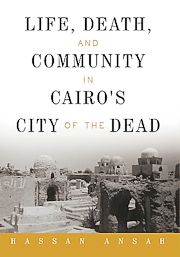- from the City of the Dead in Cairo, part 2/3
Previous Next > 3/3
The area of Qarafa belong mostly to the period Egypt was under the Burg Mamluk rulers. The first dynasty of Mamluk rulers was called Bahri Mamluk as they lived on Rhoda Island and "bahr" meaning sea, water or river. "Burg" on the other side is the word for fortress which here indicates that they ruled from and lived at Salah El Din's citadel.
The first ruler of the Burg Mamluks was Barquq
, a Circassian slave who first ruled through the Bahri Mamluk infant Naggi who was six years when Barquq usurped the throne in 1382 and established his dynasty
Barquq was son of a non-educated farmer from the area of Don River, but when he grew up in Cairo the sultan made him a powerful Emir. He had to fight Mongols and the Turks, and was able to keep the country free from both occupation forces. When he dies in 1399 it was his 13-year-old son Faraq ibn Barquq who officially took over the rule of Egypt
Several Emirs' was fighting for the position to rule though young Faraq, but when the Mongols defeated the Turkish army in 1412, this defeat had it's efferct as far as Egypt.
In Damascus the Egyptian army lost the battle against the Mongolian army and Faraq was beheaded.
Let us mention in a sidenote that Faraq's "Master of the horses who bore the name Emir Garkas El Khalili, was the one who in year 1400 established the Kahn (marketplace) of Khalili. Today the whole bazaar area here is known under his name: Khan El Khalili.
Ibn Khaldun who is considered one of the worlds first philosophers of history ("hovering as giant over a tribe of pygmies" as George Sarton formulates it) - served two periods in Cairo as Chief of Justice, and was also among those who negotiated with the Mongolian army leader Timur Lenk in Damascus. It's Tunisian born Ibn Khaldun who describes Cairo of his time as follows:
What one sees in dreams surpasses reality, but all that one could dream of Cairo falls short of the truth.
Ibn Khaldun dies 75 years of age in his beloved Cairo in 1406.
On first page of this article there is a photo of the Sufihostel (Khanqah) from the time of Sultan Al Ashraf Barshbay from 1432. The largest dome, attached to the mosque - hovers over the tomb of Sultan Barshbay. Barshbay is known to have defeated European pirates that had their base on Cyprus. These pirates had long made problems for the Muslim shipping in the eastern Mediterranean and in 1426 the sultan attacked and took their capital Nicosia. Barsbay then developed the business with India and Persia, something that provided him with a large wealth and its said that he used most of this fortune on new buildings in Cairo.
Sultan Qait Bay ruled from 1468 to 1496 and he was known for his strong taxation where one third of the country's production was taken as tax. He used most of the tax for buildings, not only new buildings but restoration of buildings from previous rulers. His hand stretched longer than Egypt, as he is known to have built and restored buildings in Syria and Arab countries.
Journeys takes Sultan Qait Bay all over Egypt, to Syria and all the way to Euphrates. Merchants from Venice, Genoa and Catalonia had to come to him as he controlled the spice trade between the Orient and Europe. When the Portuguese found the sea route to India around Africa, the capital of the spice trade move from Cairo to Lisbon.
During the last years of Qait Bay's reign, a great plague swept through Cairo and it's recorded that on one day only, 12000 people died. His only wife and daughter died as well, and in deep sorrow he passes away in 1496, over 80 years old.
Emir Qurqumas was originally a Mamluk under Sultan Qait Bay, but rose in rank to "Atabeg" (Commander in-Chief) during the rule of Sultan Qansuh al-Ghuri - one of the last Mamluk rulers in Egypt. Sultan Qansuh al-Ghuri admired Qurqumas for his benevolence, integrity and modesty and it's said that when he died 60 years old in 1510, the whole of Cairo went into morning. His tomb, or rather this beautiful mosque complex is found in what today is known as the "Eastern cemetery".
Sultan Qait Bay is followed by Sultan Tuman Bay who later looses the battle against the Ottoman army in 1516.
Egypt becomes a part of the Ottoman Empire under the new sultan, Selim the Grim - and Turman Bay becomes the last of the Mamluk rulers of Egypt.
Our walk in the City of the Dead is not over - that is not possible before we have visited the legendary tomb of Khedive Tawfik and his family.









 Life, Death, and Community in Cairo's City of the Dead
Life, Death, and Community in Cairo's City of the Dead